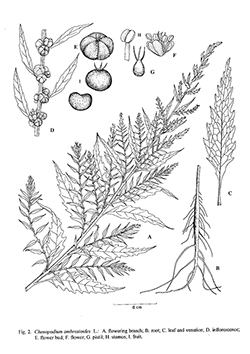e-Flora of Thailand
Volume 7 > Part 2 > Year 2000 > Page 254 > Chenopodiaceae > Chenopodium
1. Chenopodium ambrosioides L.wfo-0000600974
Sp. Pl. 1: 219. 1753; Hook.f., Fl. Br. Ind. 5: 4. 1886; Courchet in Fl. Gén. I.-C. 5: 5. 1910; Backer, Fl. Mal. 1, 4: 101. 1949; K.Larsen, Fl. C.L.V. 24: 94. 1989; P.H.Hô, Câyco Viêtnam I. 2: 916, fig. 2575. 1991. Fig. 2.
Accepted Name : Dysphania ambrosioides (L.) Mosyakin & Clemants
Ukrayins'k. Bot. Zhurn. 59: 382. 2002.
Description : Annual or biennial herb up to 1 m with young stems glandular and with a strong smell of terpentine. Leaves broadly lanceolate to elliptic, 3–10(–20) by 2–3(–9) cm, attenuate at base, irregularly dentate, rarely laciniate or nearly entire; velvetly glandulose along the nerves. Inflorescence pyramidal, richly branced, leafy panicles, consisting of cymes with 2–10(–25) sessile flowers. The numerous leaves subtending the side branches of the inflorescence are diminishing towards apex. Perianth green, 1–1.5 mm with lobes free to the middle or more. Stamens 4(–5) or less, slightly exserted. Ovary spherical; stigmata 3. Seeds obovoid, 0.5–0.8 mm, subglabrous, dark brown, shining.
Thailand : NORTHERN: Mae Hong Son.
Distribution : Cosmopolitan in the warmer parts of the world, considered neotropical of origin (type from Spain).
Ecology : Waste places, old clearings. The one Thai collection originates from an old clearing by hill tribes at Ban Tak Rai, 1,200 m alt.
Uses: Locally used for colds and stomach troubles.

